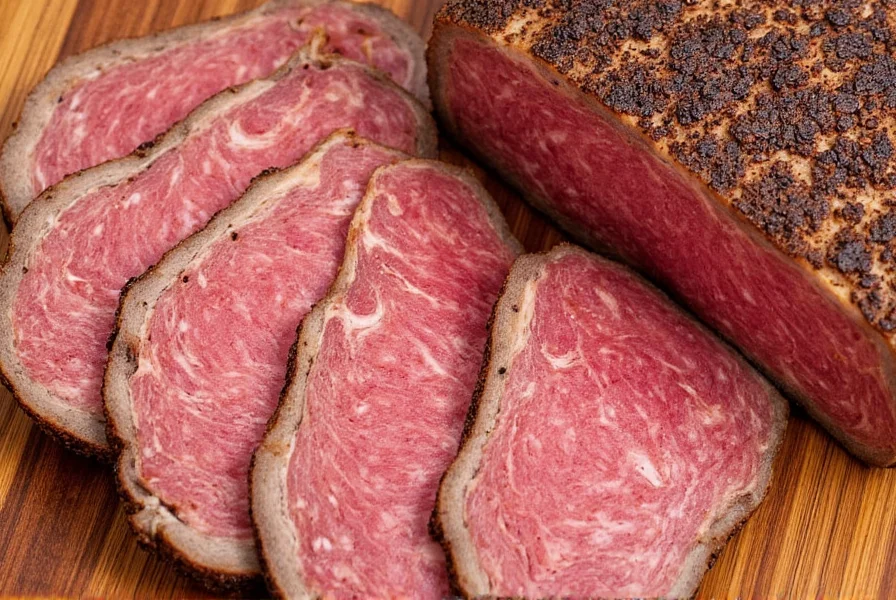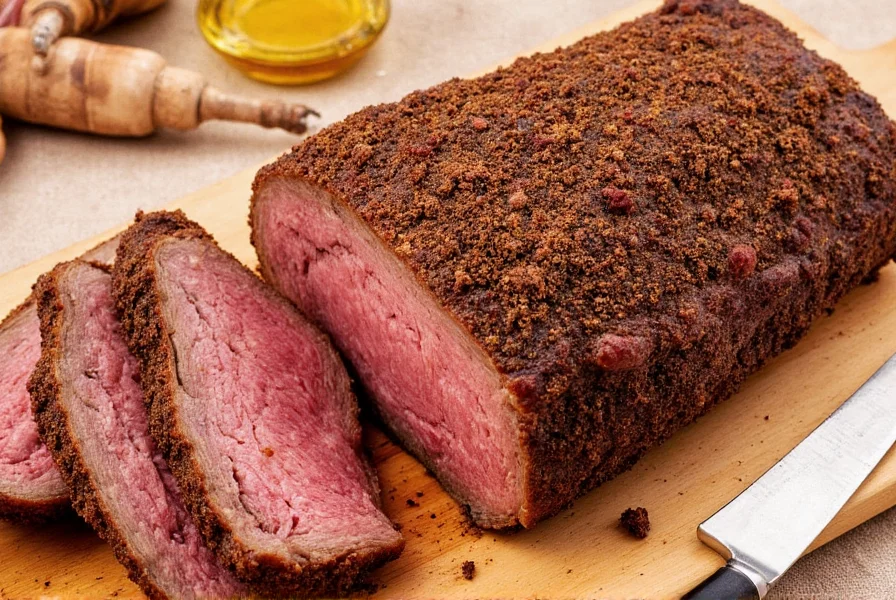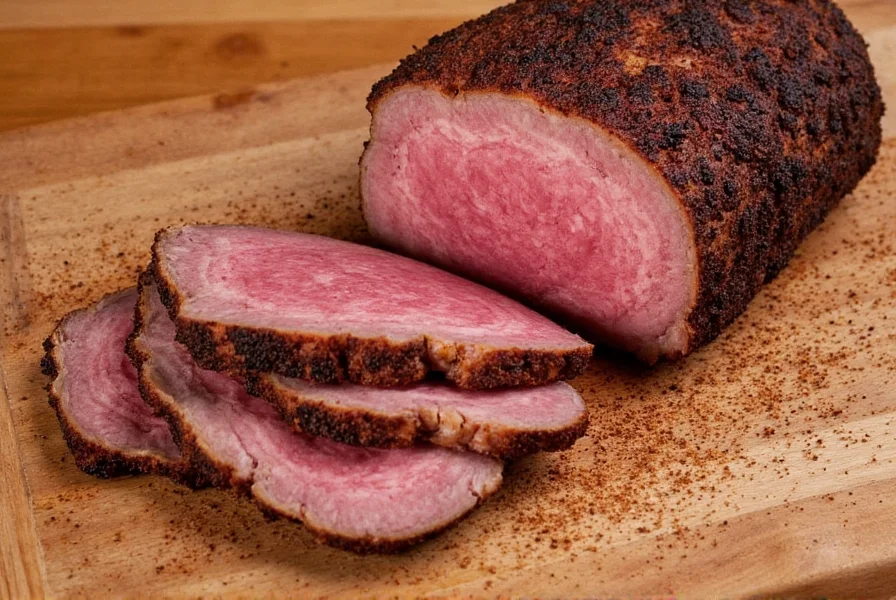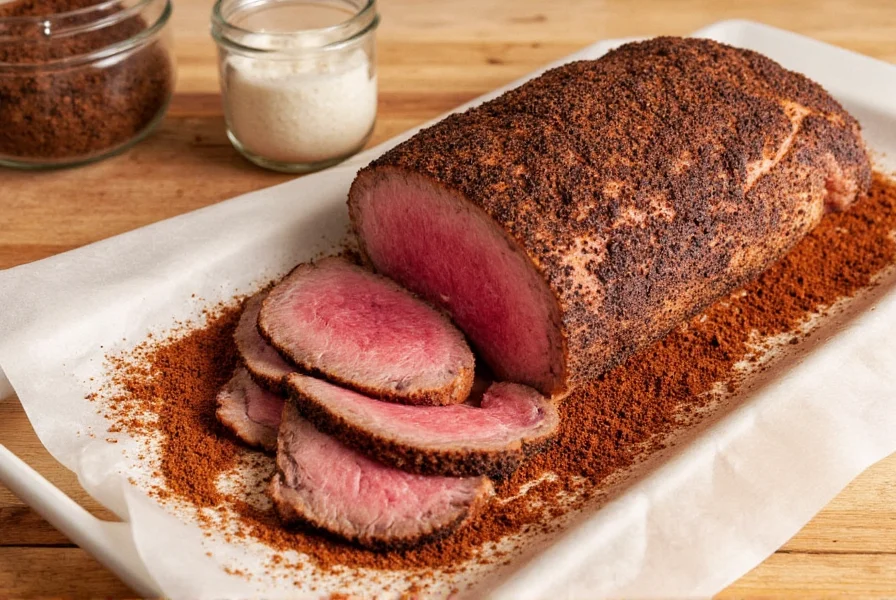What is Pastrami Rub?
Pastrami rub is a dry spice blend specifically designed to season beef brisket before smoking to create authentic pastrami. Unlike pastrami meat itself, which refers to the cured and smoked beef, pastrami rub is the seasoning mixture that gives pastrami its signature smoky, peppery flavor profile. This rub is applied after the curing process and before smoking to develop the characteristic crust and deep flavor.

Pastrami Rub vs Corned Beef Seasoning: Key Differences
While both pastrami rub and corned beef seasoning are used for curing and seasoning beef, they have distinct differences:
- Pastrami rub is applied after curing and before smoking, with more black pepper and smoked elements like smoked paprika
- Corned beef seasoning is primarily used during the brining process, with heavier mustard seed and coriander
Core Ingredients in a Classic Pastrami Rub
| Spice | Flavor Profile | Role in the Rub |
|---|---|---|
| Black Pepper | Pungent, sharp | Adds heat and bite |
| Coriander Seed | Citrusy, warm | Enhances depth and complexity |
| Fennel Seed | Earthy, licorice-like | Brings out savory notes |
| Brown Sugar | Sweetness | Balances heat and aids bark formation |
| Garlic Powder | Umami-rich, pungent | Boosts savory foundation |
| Smoked Paprika | Earthy, mild smoke | Reinforces smoky character |
| Mustard Seed | Sharp, tangy | Complements fatty meats |
Simple Homemade Pastrami Rub Recipe
Here's a classic, easy-to-make pastrami rub recipe perfect for beginners:
- 4 tbsp coarse black pepper
- 2 tbsp coriander seed (toasted and ground)
- 1 tbsp fennel seed (toasted and ground)
- 1 tbsp brown sugar
- 1 tsp garlic powder
- 1 tsp mustard seed
- ½ tsp smoked paprika

Pro Tips for Applying and Using Your Pastrami Rub
- Toast your seeds first: Toasting whole spices like coriander and fennel before grinding enhances their aromas significantly.
- Use coarse grind for better adhesion: A coarse texture helps create a flavorful crust without burning.
- Apply generously: Don't be shy — the rub should coat the meat evenly, creating a visible layer.
- Let it rest overnight: Allowing the rub to sit on the meat for 8–24 hours helps penetrate flavors deeply.
- Don't forget to inject!: For extra juiciness, consider injecting a brine or marinade along with the rub.

Common Mistakes to Avoid When Making or Using Pastrami Rubs
- Overloading with salt: Too much salt overwhelms other spices and dries the meat.
- Skipping the toast: Raw spices lack depth and can taste bitter.
- Using old spices: Stale spices ruin flavor. Keep your pantry fresh.
- Not letting the rub rest: Rushing leads to shallow flavor penetration.
- Ignoring moisture balance: If the meat is too wet, the rub won't stick properly.
How to Store Homemade Pastrami Rubs
- Use airtight containers: Mason jars or resealable spice tins work best.
- Keep away from sunlight and heat: Store in a cool, dark pantry.
- Add rice grains: Prevent clumping by adding a few uncooked rice grains to each jar.
- Label and date: Know when you made it and when it's best used by (usually 6 months).
- Check for freshness: If the scent fades, it's time to remix!
Frequently Asked Questions About Pastrami Rubs
What's the difference between pastrami rub and corned beef seasoning?
While both start with similar base ingredients, pastrami rub typically contains more black pepper and smoked elements, while corned beef seasoning leans heavier on mustard seed and coriander. Pastrami rub is applied after curing and before smoking, whereas corned beef seasoning is primarily used during the brining process.
Can I use pastrami rub on chicken or fish?
Absolutely! While traditional pastrami uses beef brisket, a lighter application of pastrami rub works beautifully on turkey breast, chicken thighs, and even salmon. Just reduce the amount by about 30% for more delicate proteins to avoid overpowering them.
How long should pastrami rub stay on meat before cooking?
For optimal flavor penetration, let the rub rest on the meat for at least 8 hours, preferably overnight in the refrigerator. This allows the spices to permeate the surface and begin interacting with the meat's proteins. For best results, apply the rub, wrap the meat loosely in butcher paper, and refrigerate for 12-24 hours before smoking.
Why isn't my pastrami rub sticking to the meat?
Rub adhesion problems usually stem from either excessive moisture on the meat surface or a rub that's too fine. Pat the meat completely dry before applying the rub, and ensure your rub contains coarsely ground ingredients. Adding a light coat of mustard or olive oil to the meat surface first can also help the rub adhere better.
Can I make pastrami rub without curing the meat first?
Yes, but you'll miss out on the authentic pastrami experience. Traditional pastrami requires both curing (to preserve and tenderize) and rubbing (for flavor). If you skip curing, you'll essentially be making seasoned smoked brisket rather than true pastrami. For authentic results, always include a curing step before applying the rub.
What's the ideal ratio of salt to spices in a homemade pastrami rub?
A balanced ratio is approximately 1:4 (salt to other spices by volume). Too much salt will overpower other flavors and potentially dry out your meat, while too little won't properly season or help form the desirable bark. Remember that some commercial rubs omit salt because they're designed to be used with a separate curing process.
Can I substitute individual spices if I don't have everything listed in recipes?
Certainly! The most flexible component is brown sugar (which can be replaced with honey powder or maple sugar). Coriander is harder to substitute but can be partially replaced with caraway in a pinch. Never completely omit black pepper in a traditional recipe, but you can adjust the amount to your taste. Fennel can be reduced if you dislike licorice notes, but it's a signature component of authentic pastrami flavor.











 浙公网安备
33010002000092号
浙公网安备
33010002000092号 浙B2-20120091-4
浙B2-20120091-4